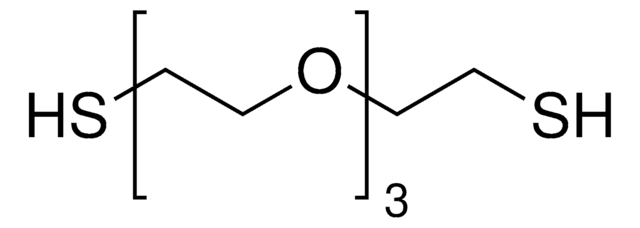729108
Poly(ethylene glycol) methyl ether thiol
average MN 800, chemical modification reagent thiol reactive, methoxy, thiol
Synonyme(s) :
Polyethylene glycol, Methoxy PEG thiol, Methoxypolyethylene glycol thiol, PEG thiol, mPEG thiol
About This Item
Produits recommandés
product name
Poly(ethylene glycol) methyl ether thiol, average Mn 800
Forme
solid
Niveau de qualité
Poids mol.
average Mn 800
Pertinence de la réaction
reagent type: chemical modification reagent
reactivity: thiol reactive
Impuretés
≤10% disulfide
Température de transition
Tm 32-37 °C
Mw/Mn
≤1.1
Extrémité Ω
thiol
Extrémité α
methoxy
Architecture des polymères
shape: linear
functionality: monofunctional
Température de stockage
2-8°C
Vous recherchez des produits similaires ? Visite Guide de comparaison des produits
Application
It can be used as a precursor to synthesize PEG conjugated poly(β-amino ester) polyplexes for gene therapy.
Mention d'avertissement
Warning
Mentions de danger
Conseils de prudence
Classification des risques
Eye Irrit. 2 - Skin Irrit. 2 - STOT SE 3
Organes cibles
Respiratory system
Code de la classe de stockage
11 - Combustible Solids
Classe de danger pour l'eau (WGK)
WGK 3
Faites votre choix parmi les versions les plus récentes :
Déjà en possession de ce produit ?
Retrouvez la documentation relative aux produits que vous avez récemment achetés dans la Bibliothèque de documents.
Les clients ont également consulté
Articles
Progress in biotechnology fields such as tissue engineering and drug delivery is accompanied by an increasing demand for diverse functional biomaterials. One class of biomaterials that has been the subject of intense research interest is hydrogels, because they closely mimic the natural environment of cells, both chemically and physically and therefore can be used as support to grow cells. This article specifically discusses poly(ethylene glycol) (PEG) hydrogels, which are good for biological applications because they do not generally elicit an immune response. PEGs offer a readily available, easy to modify polymer for widespread use in hydrogel fabrication, including 2D and 3D scaffold for tissue culture. The degradable linkages also enable a variety of applications for release of therapeutic agents.
Devising biomaterial scaffolds that are capable of recapitulating critical aspects of the complex extracellular nature of living tissues in a threedimensional (3D) fashion is a challenging requirement in the field of tissue engineering and regenerative medicine.
Notre équipe de scientifiques dispose d'une expérience dans tous les secteurs de la recherche, notamment en sciences de la vie, science des matériaux, synthèse chimique, chromatographie, analyse et dans de nombreux autres domaines..
Contacter notre Service technique






![O-[2-(3-Mercaptopropionylamino)ethyl]-O′-methylpolyethylene glycol 5,000](/deepweb/assets/sigmaaldrich/product/structures/293/792/95ae9557-6907-4575-8903-f5b87ada86e2/640/95ae9557-6907-4575-8903-f5b87ada86e2.png)




![2-{2-[2-(2-Mercaptoethoxy)ethoxy]ethoxy}ethanol 97%](/deepweb/assets/sigmaaldrich/product/structures/130/969/7d2ec2b4-e0f1-4836-aeb2-139994173612/640/7d2ec2b4-e0f1-4836-aeb2-139994173612.png)

